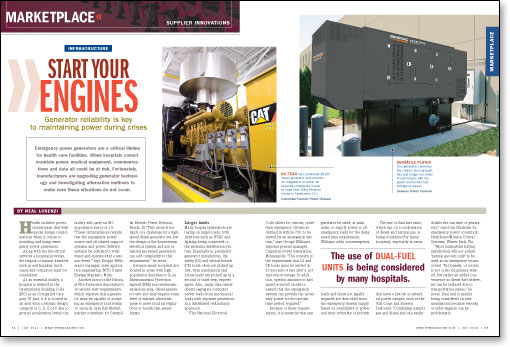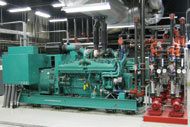 Health facilities professionals must deal with special design considerations when it comes to installing and using emergency power generators.
Health facilities professionals must deal with special design considerations when it comes to installing and using emergency power generators.
Along with the life-critical services a hospital provides, the impact of natural disasters such as earthquakes, hurricanes and tornadoes must be considered.
As an essential facility, a hospital is defined in the International Building Code (IBC) as an Occupancy Category IV. And, if it is located in an area with a seismic design category of C, D, E or F due to ground acceleration levels, the facility will carry an IBC importance factor of 1.5. "These circumstances require that the emergency power source and all related support systems and power delivery systems be certified to withstand and operate after a seismic event," says Dwight Wells, senior manager, sales application engineering, MTU Onsite Energy, Mankato, Minn.
Another factor is the National Fire Protection Association's 10-second start requirements, which stipulate that a generator must be capable of accepting an emergency load within 10 seconds, says Ray Marfell, market consultant for Caterpillar Electric Power Division, Peoria, Ill. "This alone is not much of a challenge for a high-speed diesel generator set, but the design of the downstream electrical system and use of natural gas-fueled generators can add complexity to this requirement," he notes.
Because many hospitals are located in areas with high population densities or in an Environmental Protection Agency (EPA) non-attainment emissions area, diesel generator sets also may require some level of exhaust after-treatment to meet local air regulations or health-risk assessments.
Larger loads
Many hospital generators are taking on larger loads, with functions such as HVAC and lighting being connected to the essential distribution system. Especially in paralleled generator installations, life safety (LS) and critical branch (CB) loads often are picked up first, then mechanical and house loads are picked up in a second or third step, experts agree. Also, many data center clients segregate computer server loads from mechanical loads with separate generators in a distributed redundancy approach.
"The National Electrical Code allows for circuits, other than emergency circuits as defined in Article 700, to be served by an emergency system," says George Williams, regional general manager, Cummins Power Generation, Minneapolis. "The concern is the requirement that LS and CB loads must be served in 10 seconds or less after a normal source outage. In addition, specific amounts of fuel must be stored on-site to ensure that the emergency system can provide the necessary power for the specific time period required."
Because of these requirements, it is essential that any generator be sized, at minimum, to supply power to all emergency loads for the designated time requirement, Williams adds; nonemergency loads and those not legally required are then shed from the emergency system supply based on availability of power and their criticality of priority.
The use of dual-fuel units, which run on a combination of diesel and natural gas, is being considered by many hospitals, especially in areas that have a history of extended power outages, such as the Gulf Coast and Eastern Seaboard. "Combining natural gas and diesel fuel can easily double the run time of generators," says Dan Chisholm Sr., emergency power consultant, Healthcare/Mission Critical Systems, Winter Park, Fla.
"Most [authorities having jurisdiction] will not permit 'natural gas sets only' to be used as an emergency source of fuel. The benefit, of course, is not code compliance-related, but rather an added convenience as diesel fuel deliveries can be reduced due to transportation issues," he notes. Dual fuel is mainly being considered on new installations because retrofits of older engines can be
problematic.
Dual fuel traditionally has been recommended in the Southeast, where hurricanes are an issue, due to the potential for increased run-time capability and decreased on-site fuel storage, says Marfell.
"Facilities in other areas of the country have been considering dual-fuel gensets in an effort to achieve these benefits with products perceived to be more emissions-friendly," he says. "However, dual-fuel units carry additional costs and complexity while still being subject to the same emissions and performance criteria as diesel-only generator sets, so this has yet to become a widely adopted technology."
The potential impact of natural disasters is a big factor when installing a generator. Care must be taken to ensure that generators are not damaged during cataclysmic events. This is a site-specific consideration, which often is based on pending local concerns. Airflow, fuel storage and temperature are the primary design criteria that must be accounted for to keep a generator plant operational, experts say.
The F5 tornado that hit Mercy Hospital in Joplin, Mo., in May 2011, provides an example of the importance of generator location. "Mercy Hospital took a direct hit from an F5 tornado," says Daniel Barbersek, power solutions manager, Generac Power Systems, Waukesha, Wis. "Unfortunately, the generator plant was [in the path of the tornado], so the first thing they lost was power."
Very few hospital facilities managers will consider below grade or below flood zone placement of generators, adds Brian Mauriello, vice president, sales and marketing, Kinsley Power Systems, a distributor in East Granby, Conn. "We are seeing more creative use of existing real estate — for example, pouring tall concrete structures to place the generator on top, which prevents it from being washed out in a flood," he notes. However, Chisholm advises against locating generators too high up (on rooftops).
Technology advances
With generators sometimes located in multiple locations and the need to have a functional electrical system, it is important to link each component to a centralized unit, experts agree. This can be achieved by integrating or upgrading existing controls to a building management system, or by using tablet-based software to monitor the generator plant. "Hospitals are adopting advanced technology to simplify patient care, and adopting these devices for infrastructure appears to be following closely behind," says Marfell.
Technology now allows hospitals to parallel their generators — tie multiple generators together electrically — so if one generator fails, the hospital will not lose critical loads, experts say. In the past, smaller hosÂpitals could not afford larger paralleling boards; today, this technology is readily available.
Another technological upgrade is the monitoring and trending capabilities of generators. "The big advantage is being able to trend the performance of a generator, which allows you to do predictive maintenance," says Barbersek. "There is no need to wait for it to fail; you can adjust and adapt to conditions."
One example is the Decision-Maker 3000 controller, featured on new Kohler diesel generators up to 1,000-kilowatts. Integrated into the pedestal panel, the controller uses a digital interface to provide operational data with no aftermarket add-ons, the manufacturer states. In addition, the controller configuration, diagnostics and software updates can be performed by an authorized dealer using a built-in USB port.
Another such upgrade is featured on Baldor's Industrial Diesel Liquid-Cooled (IDLC) generators, which provide system monitoring and display of oil pressure, coolant temperature, overspeed and overcrank, battery voltage, running hours and alternator volts. For peak-shaving duty, an IDLC generator can supply prime power in parallel with the local utility. In standby mode, it can supply emergency power to all critical loads and selected loads.
Due to the necessity of meeting EPA emission requirements, manufacturers have designed the newest generators to be as clean as possible, with such features as charge air cooling, electronic engine controls and exhaust after-treatment systems, says Mauriello. This reduces particulate matter and nitrogen oxide emissions as well as a facility's carbon footprint.
What's coming up?
As for future advances in generator technology, Wells sees these trends:
- A continued increase in the platform size for high-speed diesel engines;
- Vetted systems offered by engine manufacturers that can use bi-fuels (diesel fuel plus natural gas) and meet all federal and local regulations, yet allow both the transient load-pickup performance of a diesel and the benefits of cleaner emissions and longer run times (assuming the natural gas supply is augmented to be more robust as well);
- Hybrid controls that interface with facility management systems to allow faster reaction times to facility anomalies.
Williams sees a greener aspect to future generator technology, as emergency systems integrate with technologies such as fuel cells and photovoltaic devices. "I think storable nonfossil and renewable sources will become more commonplace and the existing technology will become more efficient and environmentally friendly," he says. "I expect electrical infrastructures to become more intelligent, efficient and symbiotic."
Neal Lorenzi is a writer based in Mundelein, Ill., who regularly contributes to Health Facilities Management.
| Sidebar - For more information |
| For further details on the emergency generators featured in this month's "Marketplace" article, readers can contact the following vendors: Baldor Electric Co. Caterpillar Electric Power Division Cummins Power Generation Generac Power Systems Kohler Co. MTU Onsite Energy |





